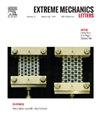Linear strain gradient-regulated bifurcation of circular bilayer plates
IF 4.3
3区 工程技术
Q2 MATERIALS SCIENCE, MULTIDISCIPLINARY
引用次数: 0
Abstract
Bilayer structures with controllable self-folding capability have found applications in a variety of cutting-edge fields such as flexible electrics, wearable devices and soft robotics. The folding of bilayer structures occurs when the mismatch strain between the two layers exceeds the bifurcation threshold, resulting in a deformation transition from an axisymmetric to a folded state. Previous efforts have predominantly focused on bilayer structures with uniform and/or anisotropic strain distributions. However, the role of non-uniform in-plane strain distributions in regulating the bifurcation of bilayer structures has not been fully understood. In this study, the effects of linear in-plane strain gradients on the bifurcation of circular bilayer plates, both with and without geometric mismatch, are systematically investigated by combining theoretical analysis, finite element simulations and experiments. Our results reveal that both the mismatch strain gradient and the geometric mismatch between the two layers play crucial roles in regulating bifurcation. Notably, linear mismatch strain gradients with larger strain at the center delay bifurcation, while those with larger strain along the edge promote bifurcation. This work offers new insights into the design of controllable self-folding bilayer structures, which is of great significance for advanced applications.
圆双层板的线性应变梯度调节分叉
具有可控自折叠能力的双层结构已在柔性电气、可穿戴设备和软机器人等多个尖端领域得到应用。双层结构的折叠发生在两层之间的错配应变超过分叉阈值时,从而导致从轴对称状态到折叠状态的变形过渡。以往的研究主要集中于均匀和/或各向异性应变分布的双层结构。然而,非均匀面内应变分布在调节双层结构分叉中的作用尚未得到充分了解。在本研究中,我们结合理论分析、有限元模拟和实验,系统地研究了线性面内应变梯度对有几何错配和无几何错配的圆形双层板分叉的影响。研究结果表明,错配应变梯度和两层板之间的几何错配在分叉过程中起着至关重要的调节作用。值得注意的是,中心应变较大的线性错配应变梯度会延迟分叉,而边缘应变较大的线性错配应变梯度则会促进分叉。这项研究为设计可控自折叠双层结构提供了新的见解,对先进应用具有重要意义。
本文章由计算机程序翻译,如有差异,请以英文原文为准。
求助全文
约1分钟内获得全文
求助全文
来源期刊

Extreme Mechanics Letters
Engineering-Mechanics of Materials
CiteScore
9.20
自引率
4.30%
发文量
179
审稿时长
45 days
期刊介绍:
Extreme Mechanics Letters (EML) enables rapid communication of research that highlights the role of mechanics in multi-disciplinary areas across materials science, physics, chemistry, biology, medicine and engineering. Emphasis is on the impact, depth and originality of new concepts, methods and observations at the forefront of applied sciences.
 求助内容:
求助内容: 应助结果提醒方式:
应助结果提醒方式:


